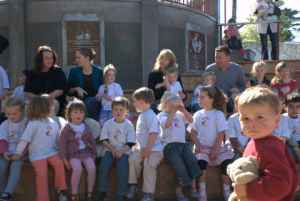International Day of Peace - Wanganui 2009
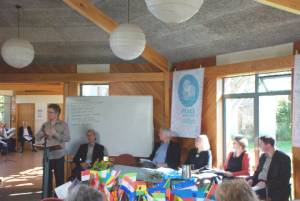
Plans for the 2009 Wanganui Peace Day celebration started with preparations for a panel discussion on the theme: Reconciliation, Truth and Bridgebuilding. But several circumstances soon expanded and transformed our initial modest plans:
The United Nations Association of New Zealand made the Wanganui Peace Day commemoration (coordinated by the UNANZ Wanganui Branch and Operation Peace through Unity) its national Peace Day event and decided to hold its forthcoming National Council meeting in Wanganui;
The decision was made for International Launch of the World March for Peace and Nonviolence to take place in Wellington on 2 October, Mahatma Gandhi’s Birthday.
This provided an irresistible opportunity to see if there was community interest in starting a contributory walk, on Peace Day from Handspan, to reach Wellington in time for the International Launch. The National Coordinator of the World March, Alyn Ware, has just been awarded the 2009 Right Livelihood Award for ‘his effective and creative advocacy and initiatives over two decades to further peace education and to rid the world of nuclear weapons”.
After some consultation with various groups within Wanganui, including Wanganui District councilors, Mainstreet Wanganui, the Quaker Community, local organizations and community members, different ideas and suggestions began to take shape and be added to the original programme. See the introductory folder for the Day. Highlights of the Peace Day events included:
Saturday, September 19
Dedication of the new little hands on Handspan:
With the Wanganui District Council agreeing to do some needed repair work on the Wanganui Peace sculpture, Handspan, in time for this year’s Peace Day, and agreeing also to add some more terracotta hands to the original thousands of hands; and with the kind cooperation of Sarjeant Gallery, offering space for Ross Mitchell-Anyon, Wanganui potter and designer of Handspan, to take new imprints of the hands of children between the age of one and six, 250 hand casts were made in the course of a few days. These were then fired and subsequently added to the beautifully spruced up sculpture. In a short ceremony on a bright Saturday afternoon these new little hands were dedicated by Chief Human Rights Commissioner, Rosslyn Noonan, to a culture of peace and non-violence for the children of the world.
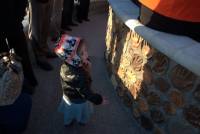
Nuclear Abolition Flame
Earlier this day, at 1 p.m. at the Wanganui – Nagaizumi Sister City Friendship Centre, the Nuclear Abolition Flame was officially welcomed to the town, and Naofumi Kanemaru, Manager of the Friendship Centre, read out a message from the Mayor of Nagaizumi for the occasion. The Mayor of Waitakere, Bob Harvey, brought the Nuclear Abolition Flame back to New Zealand after having attended the peace ceremony in Hiroshima on 5 Auguest. This flame was lit from the Hiroshima Flame, which will be maintaining the fire originating from the embers from the nuclear destruction of Hiroshima until the very last nuclear weapon is dismantled.On the 17 September three people from Wanganui; Krystal Boyes, Manu Bennett, and Naofumi Kanemaru, went to Auckland to fetch a torch with the Nuclear Abolition Flame for the Wanganui Contributory Walk. They returned with two torches! Several torches had been made for the different peace march events taking place throughout New Zealand. These will all meet up again at the International Launch, to be taken and shared by the international team on their long march for peace and nonviolence through all the world’s continents. The Nuclear Abolition Flame will eventually end up at the United Nations for the May 2010 inter-governmental nuclear non-proliferation conference.
The Friendship Centre also was the generous host of the UNANZ National Council meeting.
Glass Exhibition
On Saturday evening we were invited to attend the opening of the spectacular Wanganui Glass Exhibition at the Sarjeant Gallery, which formed part of the Annual Wanganui Glass Festival, and the busy day concluded with a joint buffet dinner at Kingsgate Hotel.
Sunday September 20
The day started bright and early with preparations for the Majestic Square festivities leading up to the Wanganui Peace Day Parade (from 10 a.m. – 12 Noon)
Wanganui Peace Day Parade
Organizer, Carla Donson, Wanganui Women’s Network, and friends, had prepared a whole programme, which included speakers and several of Wanganui’s many outstanding artists who generously donated their time and talent, bringing the place alive with music and song and sheer beautiful presence. The last contribution was offered by the Montessori school children, who melted all hearts with their performance, and were persuaded to give a repeat. The MC for this event was Greg Lincoln.
The bright red “Love Wanganui” banner, with logos of organizations and businesses sponsoring the event; two other big banners signed by people in the community (all designed by the Whanganui School of Design students), and other banners including some brought by young people from other townships, who arrived in Wanganui to make the walk from here, were all displayed, before leading the Peace Parade down the Victoria Avenue, along with the vintage cars, drums and much merriment, all watched over by the Maori Wardens. The Parade ended at the banks of Whanganui River with a little ceremony and the reading of “Like a River…”
Panel DiscussionIn the afternoon, 2 p.m. at the Quaker Settlement, some 50 people gathered for the much anticipated panel discussion on the theme Reconciliation, Truth and Bridgebuilding.
The meeting was opened with the Schola Sacra Choir, singing “The New Dawn”, Alan Cruise-Johnston’s new composition for the occasion, accompanied by a marvelous flute playing. This was followed by students from the Whanganui School of Design mentioning the names of all UN member nations, asking that peace prevail in each and all of them.
The panel consisted of :
- key note speaker Professor Kevin Clements, Director of the newly established NZ Centre for Peace and Conflict Studies;
- Rosslyn Noonan, NZ Chief Human Rights Commissioner;
- Nancy Tuaine, Manager of the Whanganui River Maori Trust Board;
- Antony Vallyon, UNANZ National President; and
- Susan Anderson, Coordinator and Facilitator for Wanganui Restorative Justice Trust
Kevin Clements opened the discussion by outlining some of the many ways the chosen theme could be seen as relevant in today’s society so full of tension and conflict: “our problem is to ensure that all states, peoples, nations avert the calamity posed by the four horsemen of the apocalypse: conquest, war, famine and death, and aspire to the ‘heavenly kingdom'”.
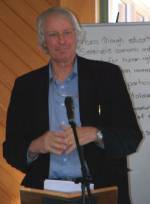
Defining reconciliation as that place ‘where peace, justice, compassion and truth come together in a transformative embrace’, Kevin went on to suggest that each of these aspirations, on their own, will not necessarily ‘generate the basis for stable peaceful relationships’: they are, he said, ‘an indivisible quartet of normal human desire. We all want to live harmoniously, be treated fairly, be sustained by love and know the truth’.
Each community would do well to observe and listen to ‘its indigenous sources of peace, strength and resilience’ and community members should ask themselves ‘how do we ensure that we reinforce unifiers and weaken the dividers’. How do we build community?
Kevin also spoke of ‘moral imagination’, which he defined as: “the capacity to imagine ourselves in an inclusive and expandable web of relationships” (including those we might not trust or feel ambivalent about), and, “the ability to sustain a problem solving curiosity that embraces complexity without reliance on dualistic polarity – either/or decision making”. He also stressed the importance of ‘slowness’ in all processes of reconciliation, truth and peacebuilding; slowness is important to ensuring that our encounters with others really do generate respect and sense of mutuality.
We need, said Kevin, to have the moral imagination which gives us: the fundamental belief in and pursuit of the creative act; and also the courage to accept the risks in peacebuilding.
With the other panelists adding invaluable and thought provoking elaborations on the theme from the perspective of human rights and responsibilities, the United Nations, restorative justice and the daily relations between peoples of different cultures and mindsets, the scene was set for a lively, constructive and enthusiastic discussion. The result was distilled into short, unedited and simple, sentences reflecting a shared commitment by the group:
Starting in our own community –
- Respect impartial justice and shared responsibility
- Develop processes and tools for healing and reconciliation
- Empathy and compassion are important and must be put into practice
- Regard and use empathy in all our daily relationships
- Acknowledge difference and build on commonalities
- Taking the time to listen and consider
- Cultivating creativity
- Love
- Minimizing ecological footprints
- Striving for joy. So very often absent especially after conflict
- Lead by example, starting from where you live, take the time to go for a walk
- Nurturing the good in each other
- Deconstruct categorization and value diversity
- Give thanks for the opportunity to come together
And taking this to the world.This statement was immediately whisked off by Kate Smith (UNANZ Branch President) who took it to the Whanganui School of Design, where the students typed it out on special paper and returned it in a beautiful container, donated by Trade Aid. This scroll was carried by the Wanganui Contributory Walk to Wellington where it was handed over to the international team of walkers as a Peace Statement from Wanganui.
It seemed an impossible task to adequately thank all those who had contributed to the Wanganui International Day of Peace events: from the speakers to all those who had been walking countless of extra miles and all the invisible helpers and angels who seemed to always appear when most needed. Throughout the time of preparation as well as the actual events themselves the spirit of generosity has been quite overwhelming.
Gita concluded her thanksgivings by sharing an experience earlier in the day:
“As I was rushing around at home preparing for this, an old notebook fell on the floor and opened on a page. Watermarks had made some of the text unreadable but on the top part of this page I had written the words of a blessing that the Hopi Elder called David had used for the opening of a Symposium that we had helped to prepare in Santa Fe, NM, in April 1982. It says: ‘May the fragrance of the flower go into every human soul, so that we may live together in peace and love and brotherhood’. In our busy lives, struggling to meet all our daily duties and challenges, the Hopi Elder reminds us that it is the fragrance; the essence of our being, which will transform the world”.Richard Thompson was the meeting’s moderator, and Hamish McDouall our MC.
Monday, September 21
Peace Vigil at the Peace SculptureOn 21st September, the International Day of Peace, several hundred people of all ages – and quite a few dogs – gathered in Queens Park and on the Handspan sculpture itself, in time for the Peace Vigil at 12 Noon. As the peel of the Wanganui church bells subsided, community members joined in silent prayer those people who, throughout the world at 12 Noon local time, were also invoking peace and the healing of all human relations.The Peace Walk Departs
Kaumatua John Maihi then invoked blessings on those who would start the long walk to Wellington and the message that they would bring with them from Wanganui. Representatives of other Faiths; Hindu, Baha’i and Muslim among them, then offered their blessings and shared, through chants, songs, and speech, their hopes for the future. Mason Esa, representing the Wanganui Muslim community, reminded us that we are all neighbours, no matter what race, creed or colour: “Diversity is our strength, not a threat”. He regretted that ‘religions are often in the news as sources of difference and conflict, whereas they all bore messages of tolerance and respect”. Mason Esa asked that we all would join in: ‘highlighting the importance of greater understanding and integration between different cultural and religious groups’.As the group walked down from the top of the Handspan spirals, they were met by two Chinese Dragons (organized by the Wanganui Chinese Association), who performed a spectacular dance, mock-challenging the first steps of the Walkers as they started for their first destination and overnight stop at the Turakina Church Hall.
The Peace Walk – September 21 – October 2
According to the text messages sent by Carla, the walkers kept in high spirit throughout the long journey and was met with ‘hospitality galore’ by their hosts along the route: from the teachers and school children at Oroua Downs to the welcome party by Paekakariki Triangle Centre and friends. ‘We had a wonderful time away, on so many levels’, said Carla, ‘a great team of folk, and lots of personal milestones
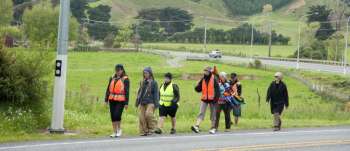
After a journey of some 207 kilometers, the Wanganui walkers arrived in Wellington in time for the International Launch of the World March for Peace and Nonviolence. Wellington City Council gave a Civic Reception on 1 October for the core international team led by Rafael De La Rubia and all those who had been involved in preparing for the national events, and of course our champion Wanganui walkers! The international team had spent the previous night on the Chatham Islands (Rekohu), the first place in New Zealand touched by the sun. Here the Hokotehi Moriori Trust had hosted the opening blessing ceremony for the World Peace March. After the Civic Reception, the group went over to the Wellington Library for the opening of the Gandhi Exhibition after which most attended a Wellington UNANZ branch forum discussion.
On Friday 2 October, Gandhi’s birthday, the World March was given a very windy send off outside the Wellington Railway station. From there, the marchers went on a walk around Wellington via Parliament grounds through the various ‘peace’ memorials, to St Andrew’s on the Terrace for a lunchtime concert for Peace, where the Topp Twins were part of the entertainment. After lunch the group broke into two – one set of ‘fitter’ people walked up to the Botanic Gardens, the other taking an easier route to end up on the waterfront. Both groups met up again in Buckle Street at the Parihaka monument. The evening was rounded off with an open forum at the Tapu te Ranga Marae. Very early Saturday morning (3.45 am) most of the core team left for Sydney, while those left behind went tree planting on the Marae reserve – a possible carbon offset for the travel? The final event in the weekend was a meeting at the Antarctica Monument on Mount Victoria where Matt Robson made a plea for each pole to become a Peace Park. Kate Smith brought OPTU’s large banner for an ‘Antarctica Peace Park – Bearing Witness to Our Change of Heart’, and spoke about that 1989 campaign which attracted some 3000 pledges and she ended with a quote from Sir Peter Scott: “Antarctica represents the crossroads facing humanity. If we can save Antarctica we can save the world.” (More on the Antarctica Monument gathering and the Antarctica World Peace Park Campaign here.)
(for more information on the other World Peace March events, nationally and internationally see www.theworldmarch.org)
Gita Brooke

